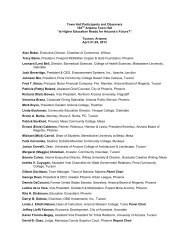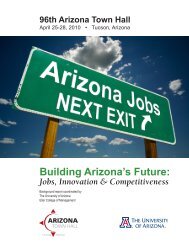Background Report - Arizona Town Hall
Background Report - Arizona Town Hall
Background Report - Arizona Town Hall
You also want an ePaper? Increase the reach of your titles
YUMPU automatically turns print PDFs into web optimized ePapers that Google loves.
The fact that only 30% of the Heard’s visitors are from <strong>Arizona</strong> means that the Heard needs to<br />
reach out to local audiences to take part in the many entertaining and educational experiences<br />
offered. We have spent the past year analyzing how we can improve our visitor experience<br />
and attract more local visitors to the museum.<br />
The Heard has an important role to play in educating our visitors about the indigenous<br />
populations of our region and of the Americas. There is a great need in <strong>Arizona</strong> for an<br />
appreciation of cultural diversity and the commonality of the human experience. The Heard<br />
is starting a new advertising campaign as a part of our outreach to <strong>Arizona</strong> residents<br />
that is based on the theme, “More in Common than You Think.” It is important that cultural<br />
and educational institutions in the valley play a leading role in raising the level of<br />
discourse and understanding.<br />
My hope is to reach more residents so they can enjoy exhibits, performances, festivals,<br />
dining, and shopping at the Heard Museum. The Heard is a world-class museum, but it is<br />
more than a museum. It is a destination.<br />
Advancing Positive Social Change Through the Arts<br />
Gordon Knox, Director, <strong>Arizona</strong> State University Art Museum<br />
The answer to the “What brought me here?” question is simple: <strong>Arizona</strong> today offers an<br />
exceptional opportunity for the arts to advance positive social change, and working with the<br />
arts toward those ends is exactly what I do. The position of Director of the <strong>Arizona</strong> State<br />
University Art Museum was an ideal match.<br />
Art is a verb; it is a way of knowing, a way of telling; it is a conversation. An object in a<br />
museum is not “art” by itself; these objects, paintings, and exhibitions become art only<br />
in relationship with the viewer, when the conversation takes place, when the ideas embedded<br />
in these object are activated by the inquisitive mind of the beholder.<br />
First and foremost, humans are social creatures. Our defining characteristics rest on collective<br />
projects and joint efforts—language, for example, is a massive multi-generational, on-going,<br />
collective project, as are market systems; tribal, national and religious identities; and the great<br />
bodies of scientific and social knowledge we have amassed over millennia.<br />
Our really big and enduring accomplishments are done together. Art is based on this<br />
collectiveness—it is a way of exploring the world and communicating to each other what we<br />
know. An art museum is a gathering place for these explorations and conversations, an<br />
articulation point for the circulation of ideas. A university museum, free and open to all the<br />
public and also linked to the full range of research and understandings underway at a<br />
university, is a powerful conduit for knowledge, a place for the exchange of ideas and<br />
understandings.<br />
We can talk at great length about the problems facing the arts today in <strong>Arizona</strong>, as they<br />
are legion: reduced budgets locally and statewide, a general perception of the arts<br />
216 | Chapter 22




